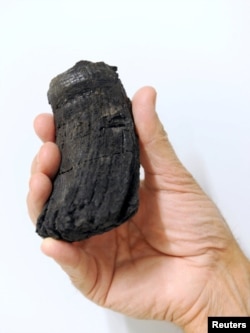Scientists have identified some remains, or fossils, of huge ancient reptiles found on mountain tops in Switzerland years ago. The researchers’ finding is a little surprising. The fossils are from ichthyosaurs, a very large animal that lived in water. But the remains were discovered many hundreds of meters above sea level.
The Journal of Vertebrate Paleontology published the study on Thursday. It describes some rib bone and backbone fossils from two ichthyosaur individuals. One bone was about 21 meters long, the other measured around 15 meters.
A tooth from a third ichthyosaur is also an important finding, says expert Martin Sander of the University of Bonn. He is the lead writer of the study.
"The tooth is particularly interesting because it could possibly - but unlikely - represent the largest animal to ever inhabit Earth," he said.
The tooth is about 6 centimeters at the base and about 15 centimeters long, the study says.
The fossils are around 205 million years old, the study found, dating them to the late Triassic Period.
The tooth came from a mountain near the Swiss city, Davos. It suggests the animal was a good hunter that could kill other large animals for food.
The ichthyosaur was the largest-ever reptile that lived in the seas. They had long bodies and small heads.
The fossils were found at three sites in the Swiss Alps during the 1970s and ‘80s, said Heinz Furrer, another study writer. Furrer is a retired scientist from the University of Zurich’s Paleontological Institute and Museum. He was one of several students that discovered the fossils years ago.
The remains are incomplete, making it impossible to confirm the exact kind of ichthyosaur made the fossils. Most likely the animals belonged to an ichthyosaur family called Shastasauridae. It includes the biggest-known ichthyosaur called Shastasaurus. It was found in Canada and believed to be 21 meters long.
Some researchers have proposed longer ichthyosaur lengths based on incomplete fossils.
Until now, huge ichthyosaurs had not been known to have lived at the end of the Triassic Period. Scientists had thought the group disappeared from Earth a few million years earlier.
The blue whale has long been considered the largest animal to have lived on Earth. It can grow to 30 meters long and weigh close to 200 metric tons.
But study writer Sander said more research on the Triassic ichthyosaur may renew questions about the planet’s largest creatures.
I’m Jill Robbins.
Will Dunham reported this story for Reuters. Gregory Stachel adapted it for VOA Learning English.
____________________________________________________________________
Words in This Story
fossil – n. something (such as a leaf, skeleton, or footprint) that is from a plant or animal which lived in ancient times and that you can see in some rocks
inhabit – v. to live in (a place)
plate – n. one of the very large sections of the Earth's surface that are believed to move and cause earthquakes where they touch each other
species – n. a group of animals or plants that are similar and can produce young animals or plants
We want to hear from you. Write to us in the Comments section, and visit our Facebook page.









